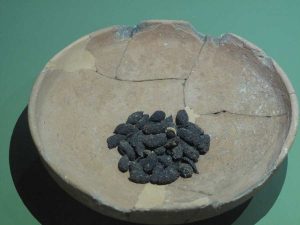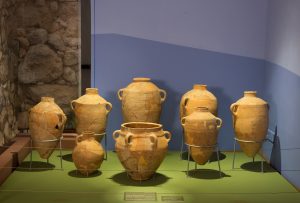Three thousand year old artifacts go on display in Jerusalem
In the US, anything more than a hundred years old is considered ancient. In Israel, anything less than two thousand years old is barely an antiquity. Now new finds shed light on life during King David’s time 3000 years ago.
A new exhibit called “In the Valley of David and Goliath” opens this week at the Bible Lands Museum in Jerusalem. It offers findings from a site called Khirbet Qeiyafa in the Ella Valley which has been identified as the location of the battle between David and Goliath. It includes an inscription that may be the oldest Hebrew writing ever to be discovered.
The finds have been dated to between the late 11th century BC, and the early 10th century BC, the time that has been associated with King David. Archaeologists are confident in the timing, as they used Carbon-14 dating on dozens of ancient olive pits found at the site, which are also on display.

Photo: Bible Lands Museum
The city was only populated for a few decades before it was destroyed, and was surrounded by a massive wall and has two large gates – an unusual feature for such a small city. The Bible mentions a city called “Sha’arayim”, which means two gates in Hebrew, and is the site of the battle of David and Goliath.
“This is an incredibly important exhibition,” Amanda Weiss, the director of the Bible Lands Museum in Jerusalem told The Media Line, as workmen put the finishing touches on the exhibition. “The timing, the finds, and the location of the city are all important.”
There is very little evidence of the Biblical King David. One of the few is an inscribed stone that was originally placed at the gate of the ancient city of Dan in the Hula Valley. The inscription in Aramaic, which is on loan to the museum for this exhibition, refers to the kingdom of Judah as “Beit David,” which means the House of David.
The exhibit is set up to mimic a walk through the actual site. You enter through two large gates, one that pointed toward Jerusalem, and one pointing to Philisita. There is a scale model reconstruction of one of the homes at the site, as well as the olive pits, and animal bones.
“They ate mainly sheep and goats, cows, and a few birds,” Yehuda Kaplan, one of the curators told The Media Line. “In Gat, a Philistine city less than ten miles away, there were a lot of pig bones. In fact, new research says that the Philistines are the ones who introduced pigs into our area from Europe.”
The fact that the residents of the city did not eat pork, does not prove that they were Jews, Kaplan says, because Canaanites did not eat pork either.

The excavations were conducted between 2007 and 2013 by senior Israeli archaeologist Yosef Garfinkel of Hebrew University, together with the Southern Adventist University of Tennessee. The Bible Lands Museum hosts 200,000 visitors a year, including Israeli and Palestinian schoolchildren. All of the explanations at the site are in Arabic as well as Hebrew, and the museum’s education unit produces materials in Arabic as well as Hebrew and English.
“I want people to walk away loving archaeology,” museum director Weiss said. “We can learn so much about ourselves from our history.”